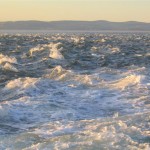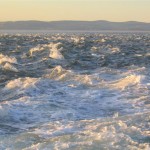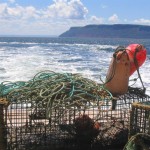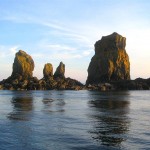Shiver me timbers! Tidal power developments are happening swiftly at this point; at least as far as the test facility goes. NS Power plans to deploy their Irish-built, OpenHydro turbine in October. Minas Basin Pulp & Power say they plan to have their test facility cable-ready as early as next summer. Scientists continue to probe the ecology of the area. And fishers look apprehensively at it, knowing the Bay can only take so much industry before further reducing their catch.
There’s been no significant ‘ground-truthing’, a term used by scientists expressing what the baseline data of an area is —the knowledge of its essential biology. This compilation of specific information is to establish relevant indicators as to what changes might result from inserting these electrical generators into the Bay. Basically, if you don’t have indicators ahead of time, it’s going to be difficult to know what’s impacted afterwards.
Lobster fisher Mark Taylor calls the Minas Passage, “the doorway to the nursery“. And the nursery is not just for lobster, but also for a myriad of other species that still migrate to the Minas Basin to spawn and feed on its nutrient rich shores. As a society, we need to be careful about the changes we impose on our environment.
During the past year, MBPP employed a team of consultants to look at the area, consider its currents & terrain, and determine where the ideal site for three turbines was for placement, testing and connecting to the grid. A combination of current strength, tidal direction, plus depth was studied. This was the main environmental assessment done to date — appraising the area for the most suitable location for the turbines.
It was determined that an area just west of Black Rock, near the Cumberland County shore, would be the best site. A background report on the Minas Passage developed last year noted there are significant gaps in the knowledge base of the area. The Fundy Marine Energy and Environment Research Network have “a suite of research questions†to be addressed prior to commercial development.
MBPP are not only building the test facility, they are also one of the proponents. They are partnering with Marine Current Turbines, who have the SeaGen, a 1.2 MW surface piercing tower that permits regular maintenance of its 15 metre dual blades. Two devices that will be tested have shielded blades inside a somewhat tubular turbine. The Canadian design being tested, like the Irish version, is submerged on a gravity-based tripod allowing it to be removed easily if deemed unsuitable for further development. The B.C. developed, Clean Current Mark III, is a 2 MW turbine, the most powerful designed to date.
An estimate by an American research firm in 2003 approximated there was 300 MW available for extraction in the Bay. Mathematician Richard Karstens, of Acadia University, has done more detailed calculations. He puts forward that there’s as much as 60 GW available, of which 5%, or 3,000 MW could be extracted before there would be any noticeable harm. This is an amount that is ten times what was originally estimated.
There is an environmental assessment of the area available at http://www.gov.ns.ca/nse/ea/minas.passage.tidal.demonstration.asp
Whatever the impacts may be to the area, they will be difficult to determine without some specific indicators established ahead of time.
Come out and learn more on July 8, 7PM at the Al Whittle Theatre.
– marke slipp



